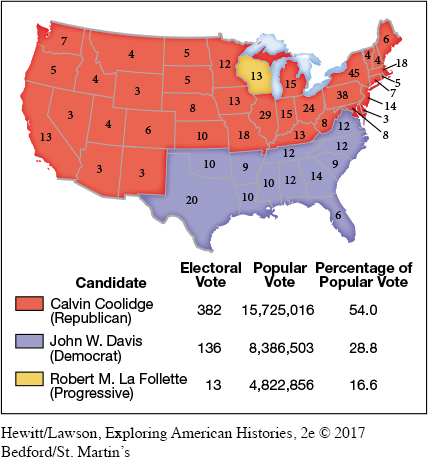The Battle for the Soul of the Democratic Party
The 1924 presidential election exposed serious fault lines within the Democratic Party. Since Reconstruction, Democrats had dominated the South, and Republicans ceased to compete for office in the region. Southern Democrats shared fundamentalist religious beliefs and support for prohibition that usually placed them at odds with big-city Democrats. The northern urban wing of the party also represented immigrants who rejected prohibition as contrary to their cultural practices. These distinctions, however, were not absolute—some rural dwellers opposed prohibition, and some urbanites supported temperance.
Delegates to the 1924 Democratic convention in New York City disagreed over a party platform and a presidential candidate. When northeastern urban delegates attempted to insert a plank condemning the Ku Klux Klan for its intolerance, they lost by a thin margin. The sizable number of convention delegates who either belonged to or had been backed by the Klan ensured the proposal’s defeat.
The selection of the presidential ticket proved even more divisive. Urban Democrats favored New York governor Alfred E. Smith. Smith came from an Irish Catholic immigrant family, had grown up on New York City’s Lower East Side, and was sponsored by the Tammany Hall machine. The epitome of everything that rural Democrats despised, Smith also denounced prohibition. After a fierce contest, the pride of New York City lost the nomination to John W. Davis, a West Virginia Protestant and a defender of prohibition. Left deeply divided going into the general election, Davis lost to Calvin Coolidge in a landslide (Map 21.1).

In 1928, however, when the Democrats met in Houston, Texas, the delicate cultural equilibrium within the Democratic Party had shifted in favor of the urban forces. With Stephenson and the Klan discredited and no longer a force in Democratic politics, the delegates nominated Al Smith as their presidential candidate.
The Republicans selected Herbert Hoover, one of the most popular men in the United States. Affectionately called “the Great Humanitarian” for his European relief efforts after World War I, Hoover served as secretary of commerce during the Harding and Coolidge administrations. His name became synonymous with the Republican prosperity of the 1920s. In accepting his party’s nomination for president in 1928, Hoover optimistically declared: “We in America today are nearer to the final triumph over poverty than ever before in the history of the land.” A Protestant supporter of prohibition from a small town, Hoover was everything Smith was not.
The outcome of the election proved predictable. Hoover trounced Smith with 58 percent of the popular vote and more than 80 percent of the electoral vote. Despite the weakening economy, Smith lost usually reliable Democratic votes to religious and ethnic prejudices. The New Yorker prevailed only in Massachusetts, Rhode Island, and six southern states but failed to win his home state. A closer look at the election returns showed a significant party realignment under way. Smith succeeded in identifying the Democratic Party with urban, ethnic-minority voters and attracting them to the polls. Despite the landslide loss, he captured the twelve largest cities in the nation, all of which had gone Republican four years earlier. In another fifteen big cities, Smith did better than the Democrat ticket had done in the 1924 election. To break the Republicans’ national dominance, the Democrats would need a candidate who appealed to both traditional and modern Americans. Smith’s defeat, however, laid the foundation for future Democratic political success.
Exploring American HistoriesPrinted Page 708
Exploring American Histories Value EditionPrinted Page 523
Chapter Timeline